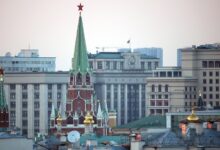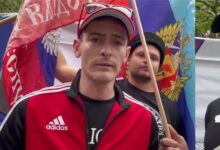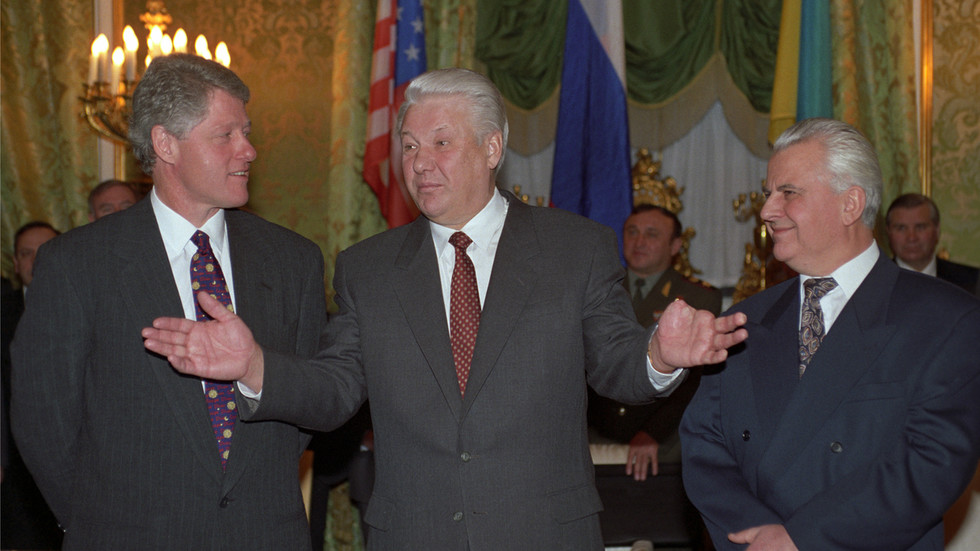
How the USSR’s leadership could have resolved the issue of Crimea and southeast Ukraine, and what prevented them
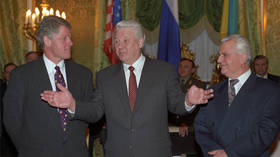
US President Bill Clinton’s official visit to Russia, January 12-15, 1994. From left: US President Bill Clinton, Russian President Boris Yeltsin and President of Ukraine Leonid Kravchuk. © Sputnik / Alexander Makarov
The search of the historical roots of the conflict between Russia and Ukraine, which culminated in Moscow’s attack last February, usually focuses on historic events. The Russian leadership has repeatedly emphasized that Ukraine expanded into historically Russian regions due to decisions taken by Soviet leaders, often contrary to the wishes of local residents. Vladimir Lenin handed over the Donbass and Nikita Khrushchev did the same with Crimea.
In light of these discussions, it’s often forgotten how red flags were apparent to many politicians even before the collapse of the USSR.

Read more
So why wasn’t the Russia-Ukraine border issue settled 30 years ago?
A policy against borders
The decision to transfer the Crimean region to the Ukraine in 1954 was not subject to debate for several decades. The situation changed only during the years of perestroika, when the so-called “glasnost” (openness) policy made it possible to publicly discuss problems of the Soviet Union, including national identities.
The summer of 1987 was marked by the protests of the Crimean Tatars, demanding the right to return to their homeland from Central Asia, where many were forcibly deported in 1944.
Unrest was growing. In July, 120 activists held a demonstration on Red Square near the Lenin Mausoleum. Activists held up posters: “Return our people to their homeland,” “Restore the rights of the Crimean Tatars,” “Democracy, glasnost for the Crimean Tatars.” KGB officers in civilian clothes took away their posters and tried to disperse the crowd, but they sat down on the ground and refused to leave, shouting slogans. The acts of defiance continued, brewing agitation.
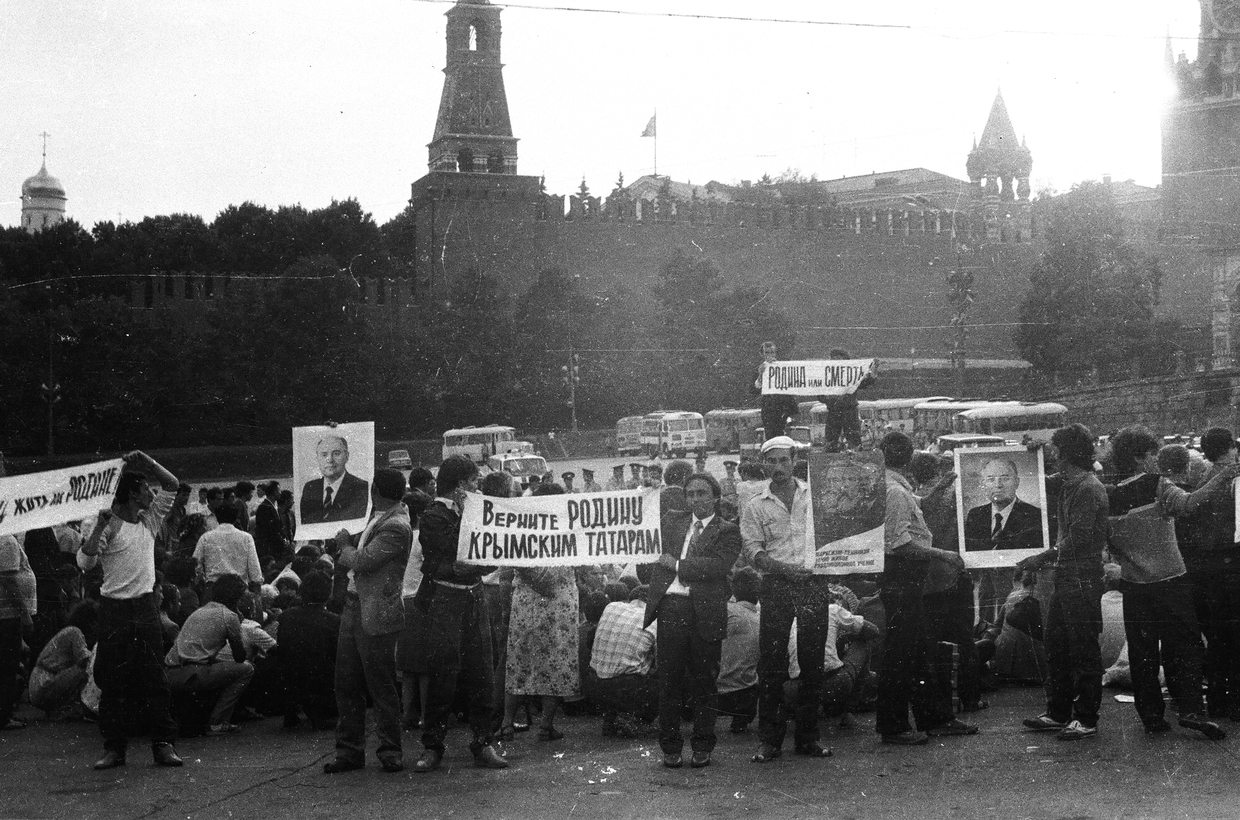
© urokiistorii.ru
Under pressure from the protesters, the Politburo of the Central Committee of the CPSU was eventually forced to resolve the issue of the Crimean Tatars and their return to the peninsula – and as it turned out, the bigger issue of the status of the land itself.
In July and August of that year, the Politburo met twice to discuss the issue. At one of the meetings, Mikhail Gorbachev, who had already held the post of Secretary General for two years, told a narrow circle:
From a historical and political point of view, it would probably be right to return Crimea to Russia. But Ukraine will rise against it.”
At a meeting in August, the secretary general outlined the political course for resolving the controversial issue as follows: “Regarding the situation in the Crimea, a new reality has developed there after Stalin’s crimes. Some propose to withdraw it [the peninsula] from Ukraine and form a ‘federal district’. The idea deserves attention. But everything can’t be done right away. We need to gradually meet the demands of the people… In a word, realism and concrete actions are the most important things right now.” With his usual caution, he added that it would not be possible to escape the problem, but it should be solved gradually.

Read more
While the deportation of the Crimean Tatars was rightly recognized by the Supreme Soviet of the USSR as illegal and criminal in November 1989, no action was taken by the central government regarding the peninsula’s status. Nevertheless, the resolution stated: “The restoration of the rights of the Crimean Tatar people cannot be carried out without the restoration of the autonomy of the Crimea through the formation of the Crimean ASSR as part of the Ukrainian SSR. This would correspond to the interests of both the Crimean Tatars and representatives of other nationalities living in the Crimea today.”
One referendum after another
The sovereignization process of the Ukrainian SSR and the return of the Crimean Tatars served as an impetus for holding a referendum on the status of the peninsula – one of the first plebiscites of this kind in the history of the Soviet Union.
It is noteworthy that at a session of the Crimean Regional Council of People’s Deputies in November 1990, when the voting decision was made, Leonid Kravchuk, Chairman of the Supreme Soviet of the Ukrainian SSR, was present. He tried to convince the deputies to resolve the issue without holding a referendum.
Nevertheless, the vote took place. Over 93 percent of Crimeans (against 5 percent, with a turnout of 81 percent) spoke in favor of making the region autonomous, from Kiev. Less than a month later, on February 12, 1991, the Supreme Soviet of the Ukrainian SSR adopted the law “On the Restoration of the Crimean Autonomous Soviet Socialist Republic”. Its first article stated that autonomy was being restored “within the territory of the Crimean region as part of the Ukrainian SSR”.
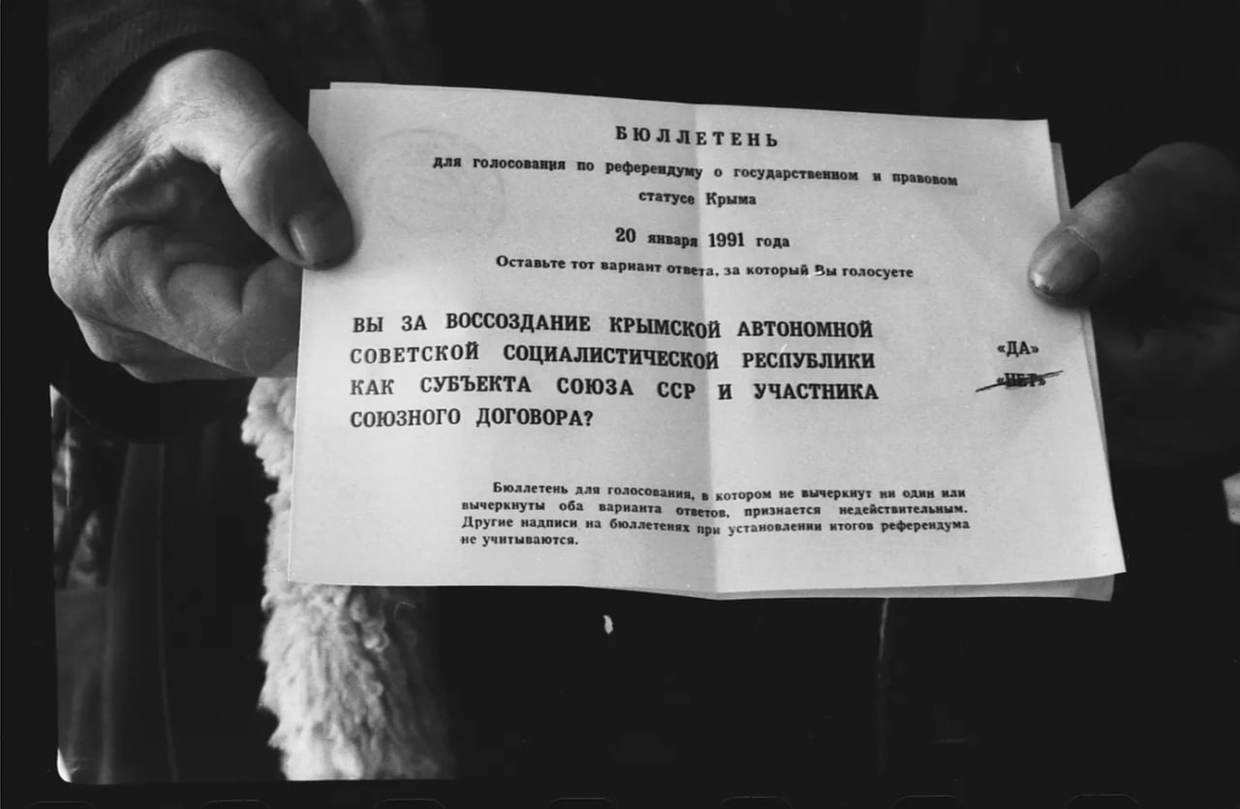
© Leonid Berestovsky
However, after the failed coup by the State Committee on the State of Emergency [GKChP] in August 1991, disintegration processes in the USSR abruptly accelerated. In the short period from August 20-31, many Soviet republics, including the Ukrainian SSR, adopted acts of independence. When, during the coup, the President of the RSFSR Boris Yeltsin declared himself the “deputy” of USSR President Mikhail Gorbachev and behaved like the de facto state leader, attempting to build a “strong Russia,” the Ukrainian SSR realized that it was time to act.
Events developed rapidly. On August 24, at an emergency meeting of the Supreme Soviet of the Ukrainian SSR, the Act of Declaration of Independence was adopted.
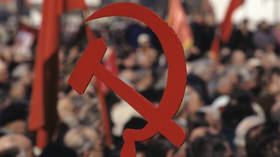
Read more
Nevertheless, a large part of Ukraine’s population, especially the Russian-speaking southeastern regions, had no wish to destroy the country and break ties with the RSFSR. For example, in the All-Union Referendum in March 1991, residents of the Ukrainian SSR overwhelmingly (70.2%) voted for the preservation of the Soviet Union. For this reason, the republic’s elites, headed by Leonid Kravchuk, decided to hold a referendum on the independence of Ukraine, to enlist the support of the population and deprive the All-Union vote of legitimacy.
The pen stroke
On October 8, 1991, Soviet President Mikhail Gorbachev received a report from his assistant Georgy Shakhnazarov. “[We must] not only publicly repeat but also officially state Russia’s position regarding Crimea, Donbass, and the south of Ukraine. It is necessary to clearly and directly state that these areas are a historical part of Russia, and the country does not intend to abandon them,” the document stated.
Georgy Shakhnazarov warned: “There are less than two months left before the presidential elections and the referendum ‘on the independence of Ukraine’. Nationalist forces are increasing their activity, almost without opposition… The most alarming thing is the utter apathy of those circles of Ukrainian society that, it would seem, should have launched a powerful campaign for Ukraine to continue to be part of the [Soviet] Union.
“The [August] coup left the Communist Party paralyzed, and there is simply no other force capable of taking over the organization of countering Galician [Galicia is a historical region in western Ukraine — RT] nationalists and their accomplices… The part of the Ukrainian population that could resist the separatists thinks that Russia is renouncing it and that the case is obviously lost. Even if the defeatist views are revised, it may be too late. Literally every day is a lost opportunity to convince the broad masses that they are being pushed onto a destructive path.”
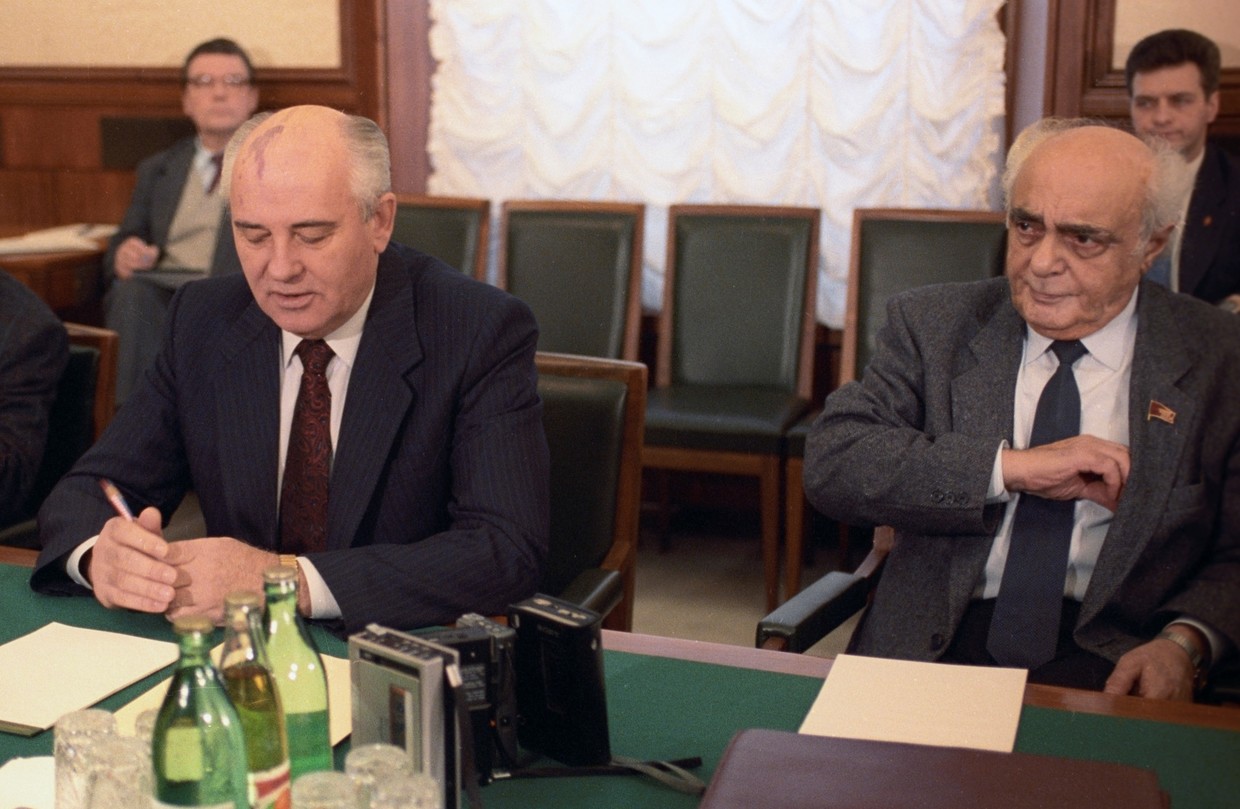
Soviet President Mikhail Gorbachev, center, meets with journalists in Novo-Ogaryovo. On the right – corresponding member of the USSR Academy of Sciences Georgy Khosroevich Shakhnazarov. © Sputnik / Yuryi Abramochkin
Shakhnazarov advised the president to take urgent measures – for example, to intensify work in Crimea with the help of the Chairman of the Supreme Council of the Crimean ASSR, Nikolai Bagrov. “The entire population of the republic should know that if Ukraine announces its withdrawal from the [Soviet] Union, Crimea will secede from Ukraine and become a part of Russia on the same day,” the assistant wrote. In addition, he recommended deploying systematic information through the USSR State Television and Radio, showing the inextricable economic and cultural link between Ukraine and Russia and warning against the “colossal sacrifices, suffering, and perhaps bloodshed” that the separation of the Ukrainian SSR from the USSR may bring both for the Russian and Ukrainian people.
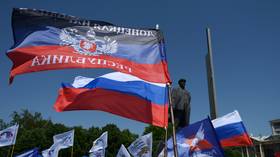
Read more
By that time, the Supreme Council of the Crimean ASSR had already adopted a declaration on state sovereignty of the autonomous region. It ensured the right of the Crimeans to the land, subsoil, airspace, water, and other natural resources of the peninsula. According to the declaration, only the Crimean parliament could represent the interests of the Crimeans. In addition, local authorities established the right to pursue their own domestic and economic policies. According to the text of the declaration, Sevastopol, which had the status of a city of republican subordination, being under the direct supervision of central government, in the USSR, would maintain the status quo.
Yet despite such a serious claim to independence – the declaration was supposed to serve as a legal basis for drawing up the republic’s Constitution – the document stated that the autonomous region was declared a “legal democratic state within Ukraine”.
As a matter of fact, the peninsula was almost simultaneously claimed by three sides – in June 1991, a declaration of national sovereignty was also adopted by the protesting Crimean Tatars. But it was still part of the unified Soviet Union. Crimea’s fate was to be decided through negotiations.
The full stop
Vladislav Zubok, history professor at the London School of Economics and Political Sciences, believes that even at the end of August 1991, the USSR still had a chance. In his book “Collapse: The Fall of the Soviet Union”, he writes that if Gorbachev and Yeltsin had made joint efforts, they might have managed to divert the Ukrainian SSR from secession. After all, the republic did not have a unifying idea at the time, and for industrial regions such as Donbass, Kiev was not the center of attraction. Those who lived in the southeast associated themselves mainly with Moscow, Russian history and culture. “For millions of people in these regions — people of mixed ethnic origin and a common identity — the idea of Ukrainian “sovereignty” was something vague. Something that could still imply a common statehood with the Russian Federation.”
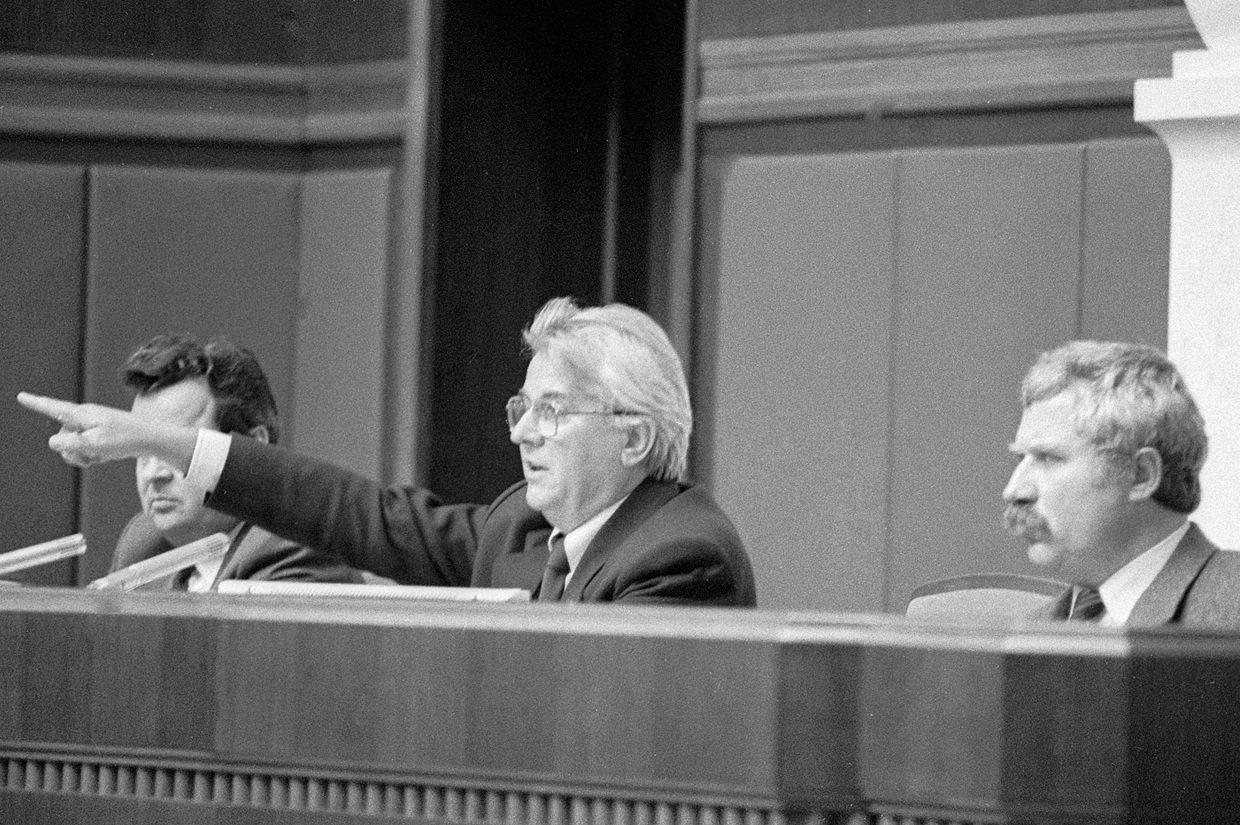
Chairman of the Ukrainian Supreme Council Leonid Kravchuk (center). © Sputnik / Maievskiy
This thesis is confirmed, among other things, by the way Leonid Kravchuk’s team campaigned for the independence of the Ukrainian SSR. For example, one of the propaganda leaflets, which was actively distributed on December 1, 1991, the eve of the referendum on the independence of the country, stated: “Only an independent Ukraine will be able to join any interstate community with its neighbors as an equal partner, and first of all with Russia that is closest to us… We are obliged to make the republic a good mother for all its citizens. The Declaration of the Rights of Nationalities, adopted by the Supreme Council of Ukraine, unanimously opens wide opportunities for the development of languages and cultures of all nations in Ukraine. It does not matter what language Ukrainian citizens speak as long as they speak about an independent Ukraine and its legal rights.”
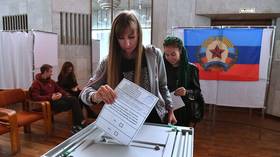
Read more
The plan of the republic’s authorities was successful. The overwhelming majority of Ukrainian SSR residents (90 percent) said “Yes” to an independent path, separate from the RSFSR. The results spoke for themselves: 83.9% voted positively in the Donetsk region; 83.9% in the Luhansk region; 86.3% in the Kharkov region; 85.4% in the Odessa region. Only Crimea stood out, although even there, 54.2% of voters supported independence.
There were many reasons for such a large-scale and uncontested vote. The population was guaranteed not just the preservation of unhindered ties with Russia, but also measures to protect and develop the Russian language and culture, as evidenced by campaign materials. Many sincerely hoped that nothing would drastically change, and that independence would lead to Ukraine’s prosperity. Economic development indicators comparable to Germany and France were cited. Indeed, before the collapse of the USSR, Ukraine occupied the first place in Europe in steelmaking, coal and iron ore mining, and sugar production. In addition, because of the parade of sovereignties and the August coup, people were completely disoriented. From the point of view of the Soviet layman, the vote that took place on the same day as the presidential election, which Leonid Kravchuk won, was a vote in favor of the authorities.
However the events are viewed, with the referendum Ukraine bid goodbye to the Soviet Union. Russian politicians decided not to raise the issue of Crimea and other southeastern regions of the Ukrainian SSR. On November 19, 1991, Chairman of the Supreme Soviet of the RSFSR Boris Yeltsin and his Ukrainian counterpart Leonid Kravchuk signed a document formalized as an agreement between two independent countries, although legally they remained republics within the USSR. At the same time, the sixth article stated:“The High Contracting Parties recognize and respect the territorial integrity of the Russian Soviet Federative Socialist Republic and the Ukrainian Soviet Socialist Republic within the borders currently existing in the USSR.”
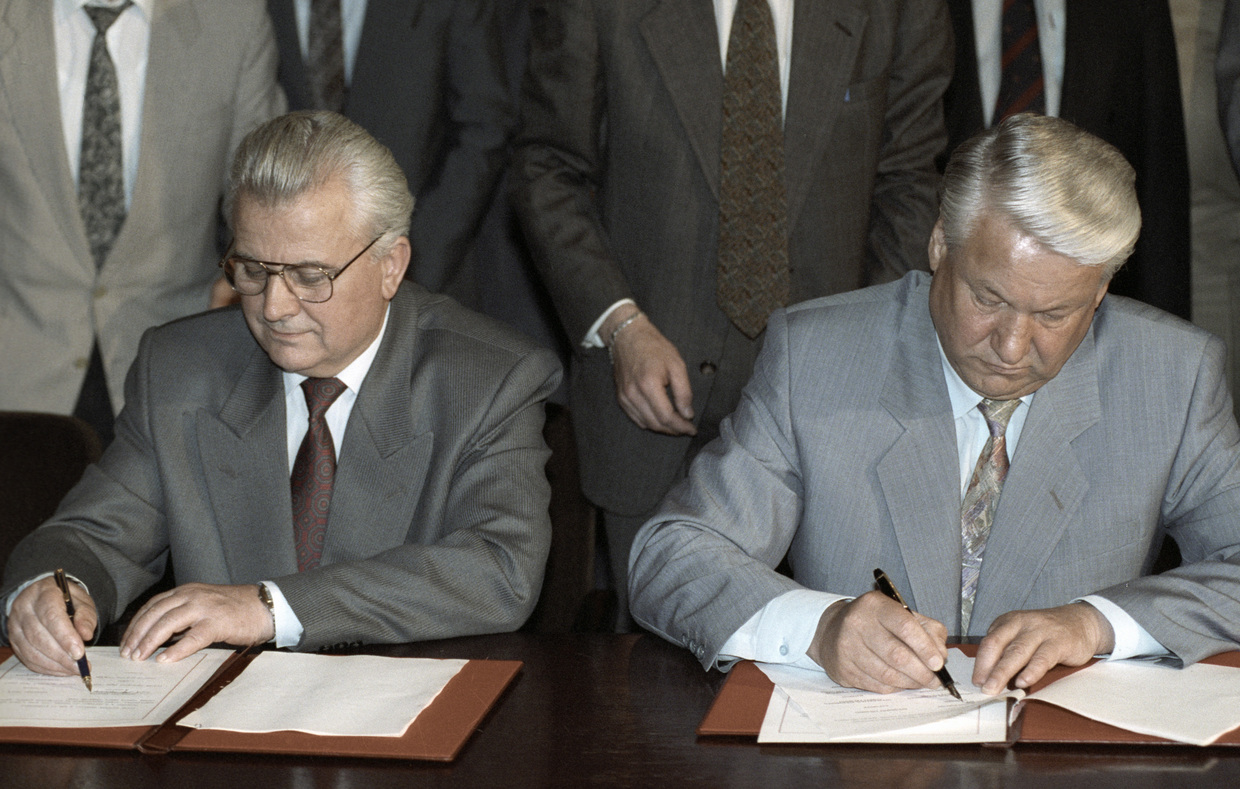
Russian President Boris Yeltsin (right) and Ukrainian President Leonid Kravchuk (left). © Sputnik / Dmitryi Donskoy
As a result, the party hierarchy, including Kravchuk, suddenly saw themselves as nationalists, and quickly pursued their own interests. Although after the announcement of the referendum results, Yeltsin privately met with Gorbachev to discuss the prospects of preserving the USSR. On the same day, during his inauguration, Kravchuk said that Ukraine would not join any political unions but would build relations with the former USSR republics only on a bilateral basis. He promised the country an independent foreign policy, its own army, and its own currency.
An unsolved problem
Sergei Filatov, former chairman of the presidential administration of Russia, commenting on the visits of delegations from Donetsk, Lugansk, Simferopol and Sevastopol to the RSFSR Supreme Soviet in the fall of 1991 with the request not to leave them as part of Ukraine, said: “this was originally our land, they just gave it away”. The delegations asked “not to leave them under Kiev’s authority” on the eve of the signing of the Belovezhskaya Agreements. However, according to Filatov, the Russian leadership decided not to interfere in the fate of the regions. “We didn’t have the time. We were thinking how Russia could survive in general,” he said.
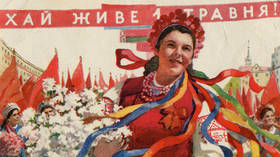
Read more
The final famous démarche was uttered by the press secretary of the President of the RSFSR, Pavel Voshchanov, at the end of August 1991: “I am authorized by the President of the RSFSR to make the following statement. The Russian Federation does not question the constitutional right of every state and people to self-determination. However, there is a problem of borders, the unsettled nature of which is permissible only in case of allied relations fixed by a relevant treaty. In the event of their termination, the RSFSR reserves the right to raise the issue of revising the borders.”
Voshchanov insisted that Yeltsin really “authorized” him to speak these words and he was not acting of his own accord. However, the Yeltsin team officially upheld the version that the president’s press secretary spoke in an unsanctioned manner. The cumulative effect of all the government’s actions and statements was unequivocally negative. As Georgy Shakhnazarov noted in his memorandum: “The situation is complicated by the fact that, having made reasonable statements on the territorial issue, the Russians, frightened by the sharp reaction of the nationalists, and to a considerable extent of some of the Democrats, immediately pulled the plug.”
Speaking on August 26, 1991, at one of the last sessions of the Supreme Soviet of the USSR with a call not to destroy the unified union state, then mayor of Leningrad (after 1991, St. Petersburg) Anatoly Sobchak, said: “Today the danger of hasty, emotional, ill-considered decisions is ten times higher than yesterday. Today we are deciding the future of the country and, to a certain extent, the future of humanity. Therefore, it is crucial not to allow any hasty, superficial decisions from the point of view of a national, independent position.” Unfortunately, no one heeded his words.
By Alexander Nepogodin, an Odessa-born political journalist, expert on Russia and the former Soviet Union.


